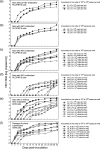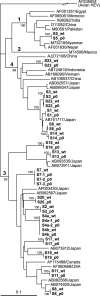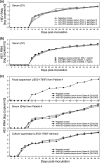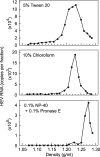Hepatitis E Virus (HEV) strains in serum samples can replicate efficiently in cultured cells despite the coexistence of HEV antibodies: characterization of HEV virions in blood circulation
- PMID: 20107086
- PMCID: PMC2849599
- DOI: 10.1128/JCM.02002-09
Hepatitis E Virus (HEV) strains in serum samples can replicate efficiently in cultured cells despite the coexistence of HEV antibodies: characterization of HEV virions in blood circulation
Abstract
We recently developed a cell culture system for hepatitis E virus (HEV) in PLC/PRF/5 and A549 cells, using fecal specimens from HEV-infected patients. Since transfusion-associated hepatitis E has been reported, we examined PLC/PRF/5 and A549 cells for the ability to support replication of HEV in various serum samples obtained from 23 patients with genotype 1, 3, or 4 HEV. HEV progenies emerged in culture media of PLC/PRF/5 cells, regardless of the coexistence of HEV antibodies in serum but dependent on the load of HEV inoculated (31% at 2.0 x 10(4) copies per well and 100% at >or=3.5 x 10(4) copies per well), and were successfully passaged in A549 cells. HEV particles in serum, with or without HEV antibodies, banded at a sucrose density of 1.15 to 1.16 g/ml, which was markedly lower than that for HEV particles in feces, at 1.27 to 1.28 g/ml, and were nonneutralizable by immune sera in this cell culture system. An immuno-capture PCR assay of HEV virions treated with or without detergent indicated that HEV particles in serum are associated with lipids and HEV ORF3 protein, similar to those in culture supernatant. By immunoprecipitation, it was found that >90% of HEV particles in the circulation exist as free virions not complexed with immunoglobulins, despite the coexistence of HEV antibodies. These results suggest that our in vitro cell culture system can be used for propagation of a wide variety of HEV strains in sera from various infected patients, allowing extended studies on viral replication specific to different HEV strains.
Figures







Similar articles
-
[Cell culture system for hepatitis E virus].Uirusu. 2010 Jun;60(1):93-104. doi: 10.2222/jsv.60.93. Uirusu. 2010. PMID: 20848869 Review. Japanese.
-
Monoclonal antibodies raised against the ORF3 protein of hepatitis E virus (HEV) can capture HEV particles in culture supernatant and serum but not those in feces.Arch Virol. 2008;153(9):1703-13. doi: 10.1007/s00705-008-0179-6. Epub 2008 Aug 5. Arch Virol. 2008. PMID: 18679765
-
Efficient cell culture systems for hepatitis E virus strains in feces and circulating blood.Rev Med Virol. 2011 Jan;21(1):18-31. doi: 10.1002/rmv.678. Rev Med Virol. 2011. PMID: 21294213 Review.
-
Development and evaluation of an efficient cell-culture system for Hepatitis E virus.J Gen Virol. 2007 Mar;88(Pt 3):903-911. doi: 10.1099/vir.0.82535-0. J Gen Virol. 2007. PMID: 17325363
-
Production of monoclonal antibodies against the ORF3 protein of rat hepatitis E virus (HEV) and demonstration of the incorporation of the ORF3 protein into enveloped rat HEV particles.Arch Virol. 2016 Dec;161(12):3391-3404. doi: 10.1007/s00705-016-3047-9. Epub 2016 Sep 8. Arch Virol. 2016. PMID: 27638774
Cited by
-
Hijacking host extracellular vesicle machinery by hepatotropic viruses: current understandings and future prospects.J Biomed Sci. 2024 Oct 5;31(1):97. doi: 10.1186/s12929-024-01063-0. J Biomed Sci. 2024. PMID: 39369194 Free PMC article. Review.
-
A Useful Method to Provide Infectious and Cultivable In Vitro Naked Viral Particles of Hepatitis A Virus.Viruses. 2024 Aug 26;16(9):1360. doi: 10.3390/v16091360. Viruses. 2024. PMID: 39339837 Free PMC article.
-
Serological and Molecular Survey of Hepatitis E Virus in Small Ruminants from Central Portugal.Food Environ Virol. 2024 Dec;16(4):516-524. doi: 10.1007/s12560-024-09612-4. Epub 2024 Sep 5. Food Environ Virol. 2024. PMID: 39235492 Free PMC article.
-
From discovery to treatment: tracing the path of hepatitis E virus.Virol J. 2024 Aug 23;21(1):194. doi: 10.1186/s12985-024-02470-3. Virol J. 2024. PMID: 39180020 Free PMC article. Review.
-
Multiple Functions of Hepatitis E Virus ORF3.Microorganisms. 2024 Jul 11;12(7):1405. doi: 10.3390/microorganisms12071405. Microorganisms. 2024. PMID: 39065173 Free PMC article. Review.
References
-
- Arankalle, V. A., and L. P. Chobe. 2000. Retrospective analysis of blood transfusion recipients: evidence for post-transfusion hepatitis E. Vox Sang. 79:72-74. - PubMed
-
- Boxall, E., A. Herborn, G. Kochethu, G. Pratt, D. Adams, S. Ijaz, and C. G. Teo. 2006. Transfusion-transmitted hepatitis E in a ‘nonhyperendemic’ country. Transfus. Med. 16:79-83. - PubMed
-
- Chandra, V., S. Taneja, M. Kalia, and S. Jameel. 2008. Molecular biology and pathogenesis of hepatitis E virus. J. Biosci. 33:451-464. - PubMed
-
- Dalton, H. R., R. Bendall, S. Ijaz, and M. Banks. 2008. Hepatitis E: an emerging infection in developed countries. Lancet Infect. Dis. 8:698-709. - PubMed
Publication types
MeSH terms
Substances
Associated data
- Actions
- Actions
- Actions
- Actions
- Actions
- Actions
- Actions
- Actions
- Actions
- Actions
- Actions
- Actions
- Actions
- Actions
- Actions
- Actions
- Actions
- Actions
- Actions
- Actions
- Actions
- Actions
- Actions
- Actions
- Actions
- Actions
- Actions
- Actions
- Actions
- Actions
- Actions
- Actions
- Actions
- Actions
- Actions
- Actions
- Actions
- Actions
- Actions
LinkOut - more resources
Full Text Sources
Other Literature Sources

